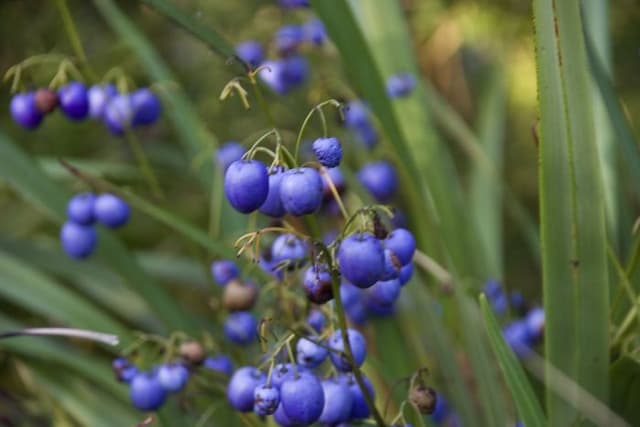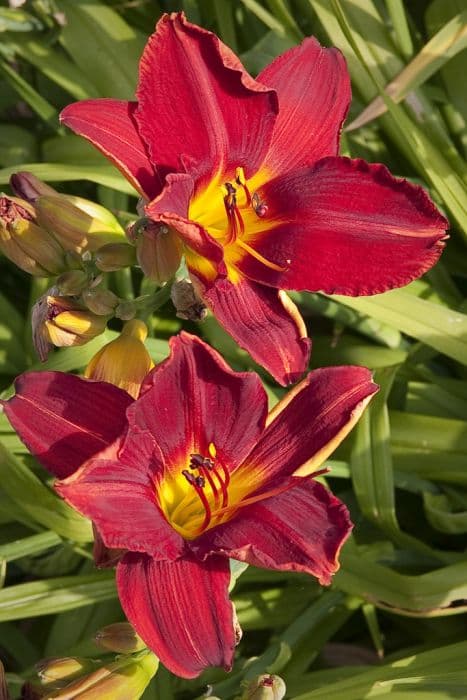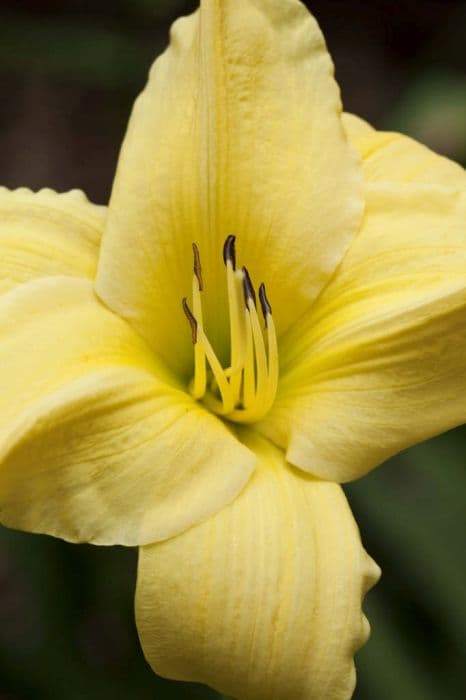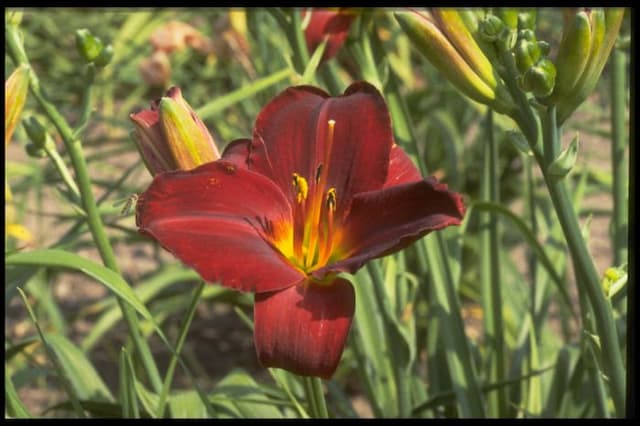Daylily Hemerocallis 'Berlin Red'

ABOUT
Hemerocallis 'Berlin Red', commonly known as the Daylily, is a striking perennial known for its vibrant flowers. The flower has a deep, rich red hue that captures the eye, making it a focal point in any garden. Each bloom consists of six broad, petal-like segments that fan out from a slightly ruffled throat, forming a circular outline. The interior of the petals is often slightly lighter in color, with a gradient that leads to a yellow or greenish throat, adding depth and contrast to the flower's appearance. The Daylily's foliage is made up of long, narrow, and arching leaves that are a bright shade of green. These leaves form dense clumps that provide a lush background to the striking flowers. The blooms are produced on long, sturdy stalks that rise gracefully above the foliage, each stalk bearing multiple buds that open successively over a period of time. This characteristic ensures a long blooming season, with new flowers regularly replacing those that have finished. The plant is recognized for its toughness and ability to thrive in a variety of conditions, making it a popular choice among gardeners. The Daylily 'Berlin Red' exudes a sense of classic elegance and drama, and its showy flowers can transform any outdoor space into an area of stunning natural beauty. Because it returns year after year, the Daylily is a dependable presence in the landscape, delighting with its recurring display of richly colored blossoms.
About this plant
 Names
NamesFamily
Hemerocallidaceae
Synonyms
Daylily, Common Daylily, Tawny Daylily, Ditch Lily
Common names
Hemerocallis 'Berlin Red'.
 Toxicity
ToxicityTo humans
Daylilies are not typically considered toxic to humans, and in fact, some species have edible parts that are consumed in certain cultures. However, it is crucial to distinguish between daylilies and true lilies (Lilium spp.), which are toxic. If you are unsure about the identity of a plant, it is best to err on the side of caution and not ingest any part of it. There are no widely recognized toxic effects of Hemerocallis 'Berlin Red' or daylilies, but individual allergies or sensitivities can occur. Always consult with a professional if you are uncertain about plant identification before considering consumption.
To pets
Daylilies, including Hemerocallis 'Berlin Red', are known to be particularly toxic to cats. Even small ingestions can be serious and result in symptoms such as vomiting, lethargy, loss of appetite, and increased thirst. More severe cases can lead to kidney failure. If you believe your pet has ingested part of a daylily plant, it is important to seek veterinary assistance immediately. The prognosis is generally good if treated early, but delays can lead to more severe consequences, including the possibility of long-term kidney damage or death.
 Characteristics
CharacteristicsLife cycle
Perennials
Foliage type
Deciduous
Color of leaves
Green
Flower color
Red
Height
2 feet (0.61 meters)
Spread
2 feet (0.61 meters)
Plant type
Herb
Hardiness zones
3
Native area
Asia
Benefits
 General Benefits
General Benefits- Easy to Grow: Daylilies are renowned for their hardiness and minimal maintenance requirements, making them perfect for both novice and experienced gardeners.
- Drought Tolerant: Once established, they can withstand periods of low rainfall, which is beneficial in areas prone to drought or for water-conservation efforts.
- Pest Resistance: Naturally resistant to many pests and diseases, reducing the need for chemical treatments and fostering a healthier garden.
- Long Bloom Time: Daylilies have a lengthy flowering period, often blooming for several weeks and offering sustained aesthetic appeal.
- Versatile Landscaping: Suitable for borders, mass plantings, and container gardens, making them a flexible option for various landscape designs.
- Soil Adaptability: They can grow in a range of soil conditions, although they prefer well-drained soils, they can tolerate less ideal soil types.
- Attracts Pollinators: Flowers attract butterflies and bees, which are essential for pollinating gardens and supporting healthy ecosystems.
- Variety of Colors and Forms: With a range of colors and forms, daylilies can provide a striking visual impact and can be used to create a vibrant garden palette.
- Edible Parts: Some parts of the daylily, such as flowers and tubers, are edible, adding an ornamental and functional aspect to gardens that cater to edible landscaping.
- Propagation: They can be easily propagated by division, allowing gardeners to expand their garden or share with others without additional cost.
 Medical Properties
Medical Properties- Hemerocallis 'Berlin Red', commonly known as Daylily, has no widely recognized medical properties for use in modern or traditional medicine. Its use for medicinal purposes is not documented in scientific literature.
 Air-purifying Qualities
Air-purifying QualitiesThis plant is not specifically known for air purifying qualities.
 Other Uses
Other Uses- As artistic ink – The petals of Berlin Red can be crushed to produce a natural red ink used for painting or fabric dyeing.
- In fish ponds – Their bright flowers can attract pollinators and beneficial insects near fish ponds, adding to the overall ecosystem health.
- As plant markers – The sturdy flower stalks can be repurposed as natural plant markers in vegetable gardens or flower beds.
- For mulch – Dried leaves and stems of the Berlin Red can be shredded to create an organic mulch for garden beds.
- As a photography subject – With their vivid red blooms, they are a popular choice for photographers looking to capture the beauty of natural flora.
- In floral crafts – The flowers can be used in dried flower arrangements or potpourri due to their color and shape.
- As a natural pest deterrent – Planting Berlin Red around the garden can help deter certain animal pests with its robust foliage and flowers.
- In educational projects – They can be used in botanical studies and school projects to teach about perennial plant life cycles.
- As compost – After blooming, the foliage and spent flowers can be decomposed into nutrient-rich compost for gardens.
- In cooking – The flowers are edible and can be used as a colorful garnish or ingredient in salads and desserts, following proper preparation.
Interesting Facts
 Feng Shui
Feng ShuiThe Daylily is not used in Feng Shui practice.
 Zodiac Sign Compitability
Zodiac Sign CompitabilityThe Daylily is not used in astrology practice.
 Plant Symbolism
Plant Symbolism- Daylily: Often associated with motherhood and fertility due to their prolific nature and ability to reproduce quickly. The daylily can also symbolize the fleeting nature of life, as each flower typically only lasts for a day.
- Red Color: The 'Berlin Red' variety, with its red hue, may carry additional meanings of passion, love, and courage which are often associated with the color red.
- Chinese Culture: In Chinese tradition, daylilies are a symbol of good luck and are believed to bring about forgetfulness of one's troubles, possibly due to their medicinal properties.
 Water
WaterDaylilies, such as the Hemerocallis 'Berlin Red', should be watered deeply, particularly during their active growing season in the spring and summer, to promote root growth. They generally require about 1 inch of water each week, whether from rainfall or irrigation. During hot, dry periods, they may need additional water, with 2 to 3 gallons per plant each week being sufficient. Avoid overhead watering to reduce the risk of leaf disease. Watering in the morning is optimal, allowing any excess moisture on the foliage to dry out over the day.
 Light
LightDaylilies like Hemerocallis 'Berlin Red' do best in full sunlight but can tolerate partial shade. They need at least six hours of sun daily to thrive and bloom profusely. The ideal spot for planting is an area that receives morning sunlight and partial shade in the hottest part of the afternoon, especially in regions with very hot summers.
 Temperature
TemperatureThe Hemerocallis 'Berlin Red' daylily is adaptable and can survive in a wide range of temperatures but thrives in conditions between 60 to 75 degrees Fahrenheit. These plants can generally withstand minimum winter temperatures down to -20 degrees Fahrenheit. To ensure vigorous growth, plant in a site that avoids temperature extremes.
 Pruning
PruningPruning daylilies, including the Hemerocallis 'Berlin Red', involves removing spent flower stalks and any damaged or yellowing leaves to encourage new growth and maintain plant health. This should be done throughout the blooming season as necessary. The best time for extensive pruning is early spring or immediately after flowering has finished.
 Cleaning
CleaningAs needed
 Soil
SoilDaylilies thrive in well-drained soil enriched with organic matter. A good soil mix for 'Berlin Red' daylily includes equal parts of loam, peat moss, and perlite or sand. The ideal pH for this daylily is between 6.0 and 6.8, so it is slightly acidic to neutral.
 Repotting
RepottingDaylilies, including the 'Berlin Red' variety, are not typically grown in containers and thus do not require routine repotting. They are perennial plants that are best planted directly into the garden.
 Humidity & Misting
Humidity & MistingDaylilies like 'Berlin Red' are tolerant of a wide range of humidity levels and do not require specific humidity conditions to thrive, making them versatile and relatively easy to grow in various climates.
 Suitable locations
Suitable locationsIndoor
Provide bright light and ensure adequate drainage for indoor daylilies.
Outdoor
Plant in sunny spot, well-drained soil; divide every 3-5 years.
Hardiness zone
3-9 USDA
 Life cycle
Life cycleThe common name of the plant, Hemerocallis 'Berlin Red', is Daylily. It starts its life as a seed or propagates vegetatively through division. Upon germination or after planting, it develops a root system and grows foliage, typically long, strappy leaves, from a central crown to form a clump. Daylilies enter a rapid vegetative growth phase in spring and early summer, leading up to the blooming period where the 'Berlin Red' variety showcases showy red flowers on tall scapes. After flowering, which occurs mainly in mid to late summer, each individual bloom lasts just one day, hence the name, but the plant will produce blooms successively. As the season turns to fall and the temperatures drop, the daylily enters dormancy, with the foliage dying back, and the plant surviving as roots and a crown underground until the next growth cycle begins in spring.
 Propogation
PropogationPropogation time
Late Summer to Early Fall
Hemerocallis 'Berlin Red', commonly known as the Daylily 'Berlin Red', is most often propagated by division, which is best done in early spring or late summer to early fall. To propagate by division, carefully dig up the entire clump of the plant, ensuring minimal damage to the roots and foliage. Using a sharp knife or spade, divide the clump into smaller sections, each with a good amount of roots and at least one or two fans of leaves. Trim any damaged roots or leaves, and replant the divisions at the same depth they were growing at previously, spacing them about 18 to 24 inches (approximately 45 to 60 centimeters) apart to allow for adequate growth. Water the newly planted divisions well to help establish them. This method is simple and effective, promoting rejuvenation and increased blooming in Daylilies.









